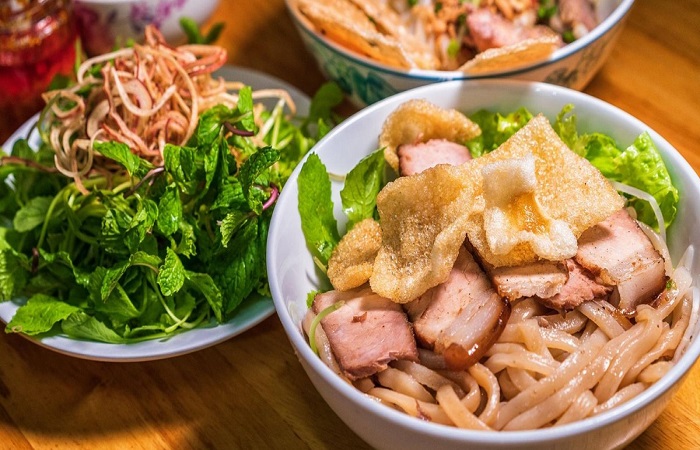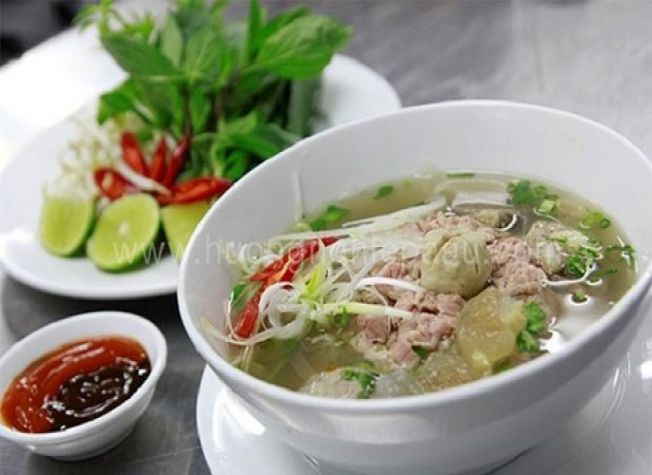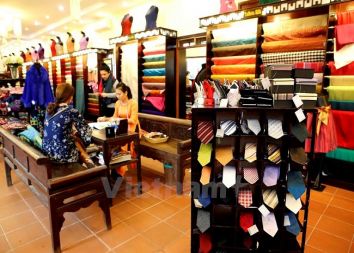Cao Lầu Hội An: Recipe of Ingredients and How to Cook
Cao Lầu Hội An is another verson of Quang Noodles (Mỳ Quảng), and is one of the must try dishes when traveling to Vietnam. History of Cao Lau date back to the 17th century, when Lord of the Nguyen allowed trade in Hoi An port, the Chinese and Japanese came here to do business, trade and live, at the same time the "delicious delicacy" named Cao Lau appeared.

Cao Lau is processed very elaborately. Unlike pho noodles, if you want to make Cao Lau, the chef must choose pure rice from Quang Nam. In particular, local people do not choose old rice but also do not choose new rice. When that standard is met, the new Cao Lau fiber is soft and chewy, and smells like the typical rice of the Central region. Rice must be soaked in ash water taken from Cu Lao Cham. After soaking, the rice will have a light yellow color like turmeric.
The water to knead the dough to make Cao Lau must be taken from the ancient well of Ba Le, because the alum in the water mixed with the flour makes the Cao Lau fiber flexible and firm. Many high floor restaurant owners when they move out of Hoi An even if they want to make this dish to sell, they can't because they don't have that unique well water.

In the stages of making Cao Lau yarn, the way to make the dough flexible and dry is the most important secret, determining the quality of the product. Unlike other types of noodles, pho and rice paper, people do not make Cao Lau by coating flour, but after kneading, Cao Lau flour will be rolled thin and then steamed. When it is ripe, the new dough is cut into large strands.
Enjoying Cao Lau without vegetables is really a big omission. To name the full name of vegetables that can be used in Cao Lau dish, there are 12 types of vegetables such as: Herbs, Cinnamon, Chamomile, Bitter vegetables, Coriander, Bean sprouts, Lettuce, Lettuce, Baby cabbage, Banana cabbage, Cucumber , Sour star fruit. However, there are 3 basic vegetables indispensable: Chrysanthemum, Bitter vegetables, Cinnamon.
Cao Lau's char siu meat must also be made from lean pork, carefully selected. Pork left in large pieces is marinated with salt sauce, five flavors to absorb evenly and then simmer. When the meat is cooked, the chef will remove the meat and continue to add tomatoes, chopped onions, oil to the broth and then continue to boil the above mixture to make the sauce. Cao Lau becomes special thanks to this char siu meat. The piece of meat is cooked just right, soft and has a very attractive brick red color.
When eating, it is easy for diners to feel that the taste of this meat is not completely Vietnamese, but it is not like the dishes of Cantonese, Fujian, Chaozhou or Japan. It can be considered as a unique taste of Hoi An Ancient Town.
To make a bowl of Cao Lau, the chef cuts a part of Cao Lau fiber into short pieces and then deep-fried it to make "shrimp", then roasted with peanuts and then covered that "shrimp" on top of the already spread Cao Lau fibers. thick in the bowl. At this point, the chef continues to lay out thin slices of fresh pink char siu with red border around the mouth of the bowl and then pour the sauce over.
When enjoying Cao Lau, you must mix it well to absorb the spices. Cao Lau is often eaten with baked rice paper (Hoi An people often choose thick coated rice paper, sprinkled with a lot of white sesame). Another special thing of Cao Lau is that Hoi An's specialty dish has no broth, only two or three spoons of sauce, so it retains its rich, greasy taste. Those who like to eat bold can add fish sauce or soy sauce.
It can be said that enjoying Cao Lau helps diners wake up all senses from the sound of noodles, the aroma of fish sauce, soy sauce, the greasy smell of fat shrimp mixed with the sweet aroma of shrimp, char siu meat, mixed with with enough pungent, bitter, acrid taste of cilantro. A dish aftertaste can only be found in Cao Lau Hoi An.
In the past, Cao Lau was still considered a high-class dish. People in rural Quang Nam every time they have the opportunity to come to Hoi An wish to once enjoy Cao Lau Hoi An and bring it back for their loved ones to enjoy. Today, this dish has become very popular in restaurants in Hoi An from spacious to popular. After hours of exploring and learning about Hoi An, visitors should take some time to experience this delicious and unique dish.
Some Best Local Places/Restaurants to Try Authentic Cao Lau in Hoi An, Quang Nam:
1. Bon Restaurant:
- Address: 474 Cua Dai
- Opening hours: 7 a.m. to 10 p.m. daily
- Price: 28,000 VND (1.20 USD)
2. Trung Bac Restaurant
- Address: 87 Tran Phu St.
- Opening hours: 7:30 a.m. to 10 p.m. daily
- Price: 30,000 VND (1.25 USD)
3. Quan An Ty Ty Restaurant
- Address: 17/6 Hai Ba Trung
- Opening hours: 8 a.m. to 11 p.m., Monday to Sunday
- Price: 30,000 VND (1.25 USD)
4. Cao Lau Khong Gian Xanh Restaurant
- Address: 687 Hai Ba Trung
- Opening hours: 10 a.m. to 10 p.m., Monday to Sunday
- Price: 30,000 VND (1.25 USD)
5. Thanh Cao Lau Restaurant
- Address: 26 Thai Phien
- Opening hours: 6 a.m. to 3 p.m., Monday to Sunday
- Price: 30,000 VND (1.25 USD)
6. Cao Lau Lien
- Address: 16 Thai Phien, Minh An Ward, Hoi An, Quang Nam
- Opening hours: 13:00 – 21:00
- Price: about 25,000 – 45,000 VND/person
7. Cao Lau Ba Le
- Address: No. 49/3, Tran Hung Dao Street, Minh An Ward, Hoi An, Quang Nam
- Opening hours: 7:00 – 22:00
- Price: about 20,000 – 45,000 VND / serving
8. Hoi An Market
- Address: The intersection of Bach Dang, Tran Phu, and Nguyen Thai Hoc streets
- Opening hours: 6:00 – 22:00
- Price: About 20,000 – 30,000 VND / serving
See Also:

Best of Vietnam

Best Vietnamese Food You Have to Try in Vietnam
Best Food in Vietnam: Vietnamese Traditional Food is top World well known to be both healthy and...

10 Best National Parks in Vietnam
Vietnam Travel Guide: If you look for the Best Wildlife Discovery Experience in Vietnam, here are...
Read More
Best Souvenir to Buy in Vietnam
If you look for Best Things to Buy when traveling to Vietnam to bring home for your family & friends...
Read More
The 10 Best Places to Visit in Vietnam
Vietnam Travel Guide: Home to an extensive collection of historical and cultural attractions,...
Read More
Top 10 Museums You Should Not Miss in Vietnam
Vietnam, 4.000 years old country has a unique and lengthy history, culture with 54 ethnic groups. It...
Read MoreFind your trip
Vietnam Best Tours
Vietnam Car Rental
Vietnam Travel Blog
- Vietnamese People: Origin, History, Culture and Traditions
- Vietnam Currency: Best ATM and Places to Exchange Money
- Vietnam Map: Regions, Cities & Provinces Map of Vietnam
- What is illegal Things in Vietnam: Rules & Laws for Tourists
- Best Time to Travel to Vietnam to Avoid the Bad Weather
- Vietnam News: Population & Religions of 54 Ethnic Groups









